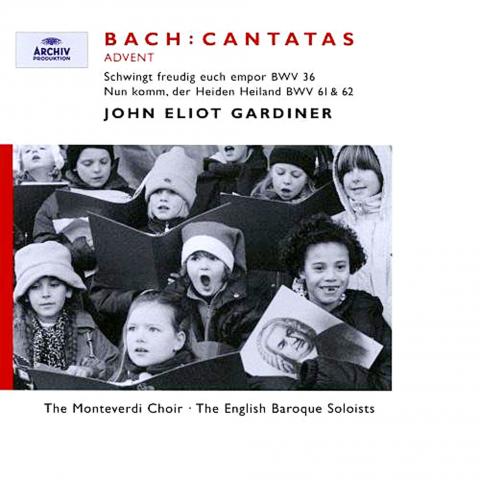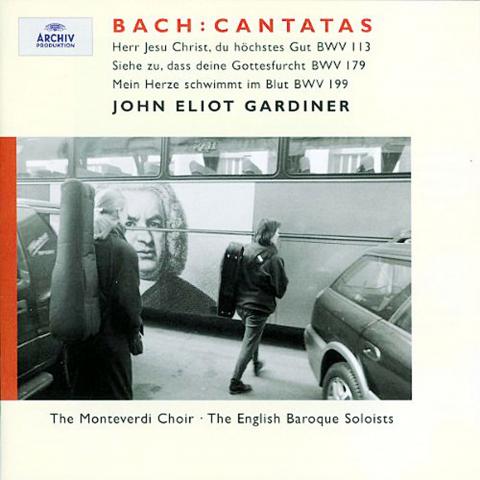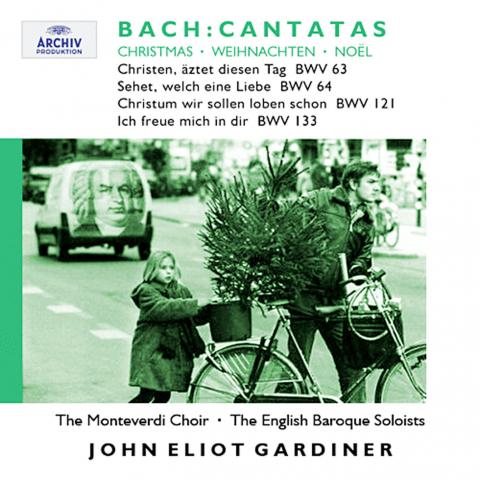I have spent the last week trying to unravel the recording history of John Eliot Gardiner’s Cantata Pilgrimage. I’m not sure I’ve succeeded.
In 2000, the 250th anniversary of Bach’s death, the UK Bach expert undertook to perform and record all the composer’s church cantatas on the days in the ecclesiastical calendar for which they were written, and in widely dispersed venues.
A boxed set of 56 CDs was duly issued last October. Most of them are on a label of Gardiner’s own, SDG — “Soli Deo Gloria” (“For God’s Glory Only,” which was how Bach signed off many of his manuscripts).

But there are other Bach cantata recordings, on Deutsche Grammophon’s Archiv label, also by Gardiner and with many of the same artists. These appear to be the residue of an earlier purported agreement between Gardiner and DGM that failed to come into complete fruition, and most of them were indeed recorded earlier than the Pilgrimage year of 2000.
Some of these Archive discs have now come into my possession. I was surprised, however, when I discovered that one of them, Archiv 463 591-2, containing cantatas 113, 179 and 199, was identical with the Cantata Pilgrimage item on SDG.
But the difficulty isn’t confined to the recording history. Bach’s own story, too, contains its own complexity.

When he arrived in Leipzig in 1723, he set to work composing a cantata a week for all the Sundays of the year. However, there are only 52 Sundays in any year, and nearly 200 church cantatas by Bach survive (some 100 more have been lost). The reality is that, firstly, Bach had written a number of cantatas in Weimar, before he got to Leipzig, and, secondly, once he had written a Leipzig cantata for each of the Sundays, he went on to compose new ones for certain Sundays when he felt the need arose.
It so happens that the standard list of Bach’s works, the Bach-Werke-Verzeichnis (Bach Work Catalogue), BWV for short, isn’t chronological but assembles its items according to category, and the cantatas are placed first. Thus a Bach cantata’s BWV number is conveniently identical to the number the cantata is known by (Cantata Number 36 is BWV 36, and so on).
I mention BWV 36 because it was the first of the Archiv recordings I listened to. It was a lucky choice because it’s a delightful work, written for the first Sunday in Advent, the fourth Sunday before Christmas and the traditional beginning of the ecclesiastical year.

If you want proof of its excellence, download track 13 of the CD on Amazon.com. On it a soprano, Nancy Argenta, sings a solo aria, Auch mit gedampften, schwachen stimmen (Also with muted, weak voices) to violin accompaniment. Gardiner has described it as “pure enchantment.” It’s almost nine minutes long, but will only cost you US$0.79.
If even that’s too much, you can hear the same item for free on YouTube, also excellently sung by the Catalan soprano Nuria Rial. If anything demonstrates Bach’s accessibility and genius it’s this aria.
Another showpiece aria is in Cantata Number 62, also written for the first Sunday of Advent. It’s for bass voice, and has a rumbustious figured accompaniment. Look that one up too online — its title is Streite, siege, starker Held! (Struggle, conquer, powerful hero!).
The CD I listened to that’s identical with Gardiner’s Pilgrimage performance is of three cantatas Bach wrote for the eleventh Sunday after Trinity. (The Sundays after Trinity fill up most of the year after Pentecost — known in the UK as Whitsun). They’re brilliant works, and here star the celebrated Czech mezzo-soprano Magdalena Kozena.
Also on that disc is BWV 199, written while Bach was still in Weimar. Its final item is an immensely cheerful gigue (the word derives from the English “jig”). All the cantatas on this disc were recorded live in St. David’s Cathedral in Wales, UK.
Another CD I greatly enjoyed contains cantatas 63, 64, 121 and 133, all composed for Christmas.
Number 63 is especially attractive — Gardiner calls it “exceptional in every sense.” It has a particularly bright, cheerful opening, appropriate for Christmas. But it’s also a highly original work — there are no angels, no shepherds, no lullaby and no traditional Christmas carol or chorale.
It so happens there’s a video of Gardiner rehearsing this cantata on YouTube. It lasts an hour and contains many fascinating comments, by Gardiner and by some of his performers, including the observation that boys’ voices broke later in 18th century Germany than they do today. No women sang in churches in Bach’s day, but Gardiner, though usually regarded as a specialist in “authentic” period performances, uses them in all his recordings, both on the Pilgrimage CDs and on Archiv.
Last October Gardiner published a book on Bach, no doubt timed to coincide with the issuing of his boxed set. It’s called Bach: Music in the Castle of Heaven (published in the UK by Allen Lane) and will be reviewed in Taipei Times shortly.
A friend, very well-informed musically, recently offered the opinion that Bach’s sacred cantatas collectively represented some of the greatest music ever written. I have to admit I was dubious. If this was the case, why weren’t there dozens of recordings of them, and from all the greatest conductors? (There are currently four high-profile complete recordings, Helmuth Rilling’s with German forces, Masaaki Suzuki’s with Japanese ones, Ton Koopman’s with Dutch ones, and Gardiner’s).
What can be said, though, is that Bach is among the very greatest of Western composers, and that his ecclesiastical cantatas represent a major part of his quite extraordinary achievement.

Taiwan Power Co (Taipower, 台電) and the New Taipei City Government in May last year agreed to allow the activation of a spent fuel storage facility for the Jinshan Nuclear Power Plant in Shihmen District (石門). The deal ended eleven years of legal wrangling. According to the Taipower announcement, the city government engaged in repeated delays, failing to approve water and soil conservation plans. Taipower said at the time that plans for another dry storage facility for the Guosheng Nuclear Power Plant in New Taipei City’s Wanli District (萬里) remained stuck in legal limbo. Later that year an agreement was reached

What does the Taiwan People’s Party (TPP) in the Huang Kuo-chang (黃國昌) era stand for? What sets it apart from their allies, the Chinese Nationalist Party (KMT)? With some shifts in tone and emphasis, the KMT’s stances have not changed significantly since the late 2000s and the era of former president Ma Ying-jeou (馬英九). The Democratic Progressive Party’s (DPP) current platform formed in the mid-2010s under the guidance of Tsai Ing-wen (蔡英文), and current President William Lai (賴清德) campaigned on continuity. Though their ideological stances may be a bit stale, they have the advantage of being broadly understood by the voters.

In a high-rise office building in Taipei’s government district, the primary agency for maintaining links to Thailand’s 108 Yunnan villages — which are home to a population of around 200,000 descendants of the Chinese Nationalist Party (KMT) armies stranded in Thailand following the Chinese Civil War — is the Overseas Community Affairs Council (OCAC). Established in China in 1926, the OCAC was born of a mandate to support Chinese education, culture and economic development in far flung Chinese diaspora communities, which, especially in southeast Asia, had underwritten the military insurgencies against the Qing Dynasty that led to the founding of

Artifacts found at archeological sites in France and Spain along the Bay of Biscay shoreline show that humans have been crafting tools from whale bones since more than 20,000 years ago, illustrating anew the resourcefulness of prehistoric people. The tools, primarily hunting implements such as projectile points, were fashioned from the bones of at least five species of large whales, the researchers said. Bones from sperm whales were the most abundant, followed by fin whales, gray whales, right or bowhead whales — two species indistinguishable with the analytical method used in the study — and blue whales. With seafaring capabilities by humans